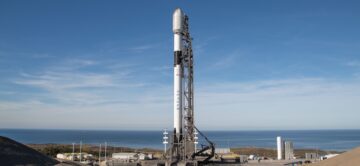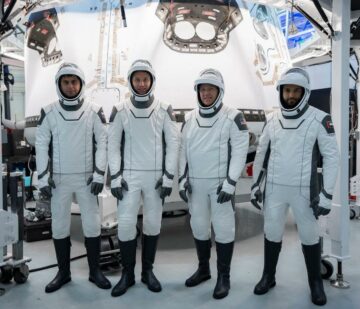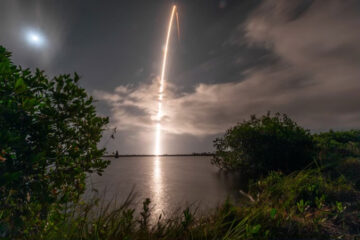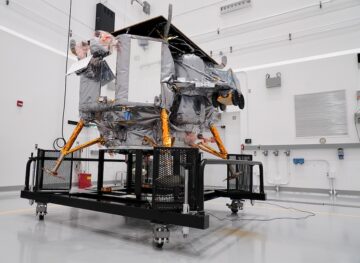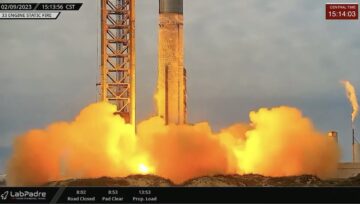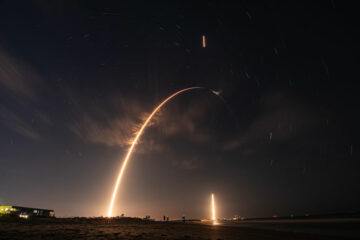
A European Vega rocket launched from French Guiana Monday night with Airbus’s second Pléiades Neo remote sensing satellite, two European Space Agency CubeSats to track space weather, a student-built nanosatellite from Italy, and a small maritime surveillance payload from the French company Unseenlabs.
The Vega rocket’s solid-fueled booster stage ignited and vaulted the 98-toot-tall (30-meter) launcher off the pad at the Guiana Space Center in South America at 9:47:06 p.m. EDT Monday (0147:06 GMT Tuesday).
Heading north from the tropical spaceport, the Vega rocket exceeded the speed of sound in less than 30 seconds and shed its spent first stage about two minutes after liftoff. Two more solid-fueled motors fired in succession to send the mission’s five payloads into space.
The rocket’s Swiss-made payload shroud jettisoned after the initial climb above Earth’s atmosphere.
A liquid-fueled upper stage, known as the Attitude and Vernier Upper Module, ignited two times to maneuver the Pléiades Neo 4 spacecraft into its targeted polar orbit at an altitude of roughly 388 miles (625 kilometers). The satellite separated from the AVUM upper stage about 54-and-a-half minutes after liftoff.
Liftoff of a Vega rocket from French Guiana, hauling Airbus’s Pléiades Neo 4 Earth observation satellite and four European CubeSats into polar orbit. https://t.co/cc7v8fPmiC pic.twitter.com/xMBAGijFfg
- Spaceflight Now (@SpaceflightNow) August 17, 2021
Two more burns by the AVUM upper stage reduced the rocket’s altitude to around 344 miles (554 kilometers) for separation of four smaller rideshare payloads more than an hour-and-a-half into the mission.
Arianespace, the French company that oversees launches from the Guiana Space Center, declared the mission a success. It was the 17th successful flight of a Vega rocket in 19 launches since 2012.
The 2,032-pound (922-kilogram) Pléiades Neo 4 atellite will take a position in a similar orbit as the Pléiades Neo 3 spacecraft that launched in April, but will fly in a slot 180 degrees from its counterpart to begin enabling repeat coverage of the same location on Earth.
The Pléiades Neo satellites feature improvements over Airbus’s first-generation Pléiades Earth observation satellites launched in 2011 and 2012. The final two Pléiades Neo satellites will launch together on an a Vega C rocket — an upgraded variant of the Vega launcher — in 2022.
Airbus says it entirely funded the development of the Pléiades Neo satellites, with intentions to sell the imagery commercially to private companies and government users. The company announced the Pléiades Neo program in 2016, and Airbus assembles the Pléiades Neo spacecraft at its facility in Toulouse, France.
Programul cu patru sateliți costă Airbus aproximativ 600 de milioane de euro, sau aproximativ 700 de milioane de dolari.
The Pléiades Neo satellites can produce optical imagery of Earth’s surface with a resolution of 11.8 inches, or 30 centimeters, according to Airbus. That’s good enough to resolve features such as vehicles and road markings.
“Pléiades Neo will offer a truly best-in-class capability to our customers and will strongly enhance our position in the very high-resolution market” said François Lombard, head of intelligence at Airbus Defence and Space. “The first images from Pléiades Neo 3 are outstanding and confirm that we took the right decision in terms of design and performance to address the increasingly demanding requirements of the geospatial sector.”

Rezoluția imagistică a celor patru sateliți Pléiades Neo ai Airbus este comparabilă cu rezoluția oferită de sateliții de supraveghere WorldView Legion de la Maxar, care urmează să înceapă lansarea anul viitor. Companiile sunt concurenți, oferind imagini de observare a Pământului cu cea mai înaltă rezoluție de pe piața comercială globală.
Cu ajutorul legăturilor laser de comunicații inter-satelit, sateliții Pléiades Neo vor putea răspunde rapid la solicitările de sarcini în termen de 30 până la 40 de minute, potrivit Airbus.
Un singur satelit Pléiades Neo, care utilizează o nouă capacitate de indicare agilă, activată de giroscoape de control moment, se poate întoarce dintr-o parte în alta pentru a observa aceeași locație la fiecare două zile. Odată ce toți cei patru sateliți sunt pe orbită, constelația va putea să imagineze orice locație de pe Pământ de două ori pe zi.
Each Pléiades Neo spacecraft is designed to operate for at least 10 years.
One Pléiades Neo satellite can collect images covering an area of nearly 200,000 square miles (500,000 square kilometers) every day, Airbus says.
Airbus released the first images from the Pléiades Neo 3 satellite in May. The company plans make commercial imagery from Pléiades Neo 3 available to customers later this year.
One of the rideshare payloads launched Monday night is a briefcase-sized six-unit CubeSat for a French startup company named Unseenlabs founded in 2015.
The small spacecraft, named BRO-4, is the fourth satellite in the company’s growing constellation designed to provide maritime surveillance services. The three previous satellites launched aboard Rocket Lab missions.
Unseenlabs says its fleet of nanosatellites will be able to locate and identify ships around the world, providing tracking services for maritime operators and helping security forces watch for pirates and smugglers. The company plans to build out a fleet of 20 to 25 nanosatellites by 2025.

Three small CubeSats sponsored by the European Space Agency also launched on the Vega rocket.
The RadCube spacecraft is a three-unit CubeSat was developed by a Hungarian company named C3S. Designed as a technology demonstration mission, RadCube carries instruments to measure radiation and magnetic fields in low Earth orbit, collecting important data for space weather forecasting.
ESA’s SunStorm CubeSat, developed by Reaktor Space Lab in Finland, will test a miniature solar X-ray flux monitor measuring X-ray missions from coronal mass ejections, huge eruptions from the sun’s surface that can generate space weather storms affecting satellite operations, and power grids and communications networks on Earth.
The instrument to be tested on the SunStorm nanosatellite is similar to a sensor ESA plans to fly on a future operational space weather monitoring mission.
The third ESA-supported CubeSat on Monday night’s launch was LEDSat, a small spacecraft developed by students at Sapienza University of Rome. The mission is designed to investigate the performance of Light Emitting Diodes as a way of tracking satellites in low Earth orbit, according to ESA.
ESA selected the LEDSat mission for a rideshare launch opportunity through the agency’s “Flight Your Satellite!” educational program.
E-mail autorul.
Urmăriți-l pe Stephen Clark pe Twitter: @ StephenClark1.
- "
- 000
- 11
- 2016
- 9
- TOATE
- America
- a anunțat
- Aprilie
- ZONĂ
- în jurul
- construi
- Colectare
- comercial
- Comunicații
- Companii
- companie
- concurenți
- credit
- clienţii care
- de date
- zi
- apărare
- Amenajări
- Dezvoltare
- de învăţământ
- SAE
- european
- euro
- Facilitate
- Caracteristică
- DESCRIERE
- Domenii
- First
- FLOTA
- zbor
- Franţa
- finanțate
- viitor
- Caritate
- bine
- Guvern
- În creştere
- cap
- HTTPS
- mare
- identifica
- imagine
- Imaging
- inci
- Inteligență
- investiga
- IT
- Italia
- cu laser
- lansa
- lansează
- ușoară
- locaţie
- Maritim
- Piață
- măsura
- milion
- Misiune
- luni
- Monitorizarea
- NEO
- rețele
- North
- oferi
- Operațiuni
- Oportunitate
- performanță
- de lire sterline
- putere
- privat
- Program
- Radiaţie
- Cerinţe
- satelit
- sateliți
- securitate
- selectate
- vinde
- Servicii
- Distribuie
- navelor
- mic
- solar
- Sud
- America de Sud
- Spaţiu
- nave spaţiale
- zbor în spațiu
- viteză
- Sponsorizat
- pătrat
- Etapă
- lansare
- succes
- de succes
- Suprafață
- supraveghere
- Tehnologia
- test
- urmări
- Urmărire
- tweet
- stare de nervozitate
- universitate
- utilizatorii
- Vehicule
- Video
- Ceas
- în
- lume
- an
- ani


